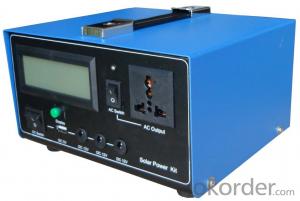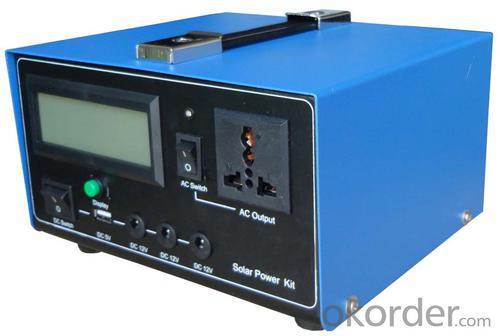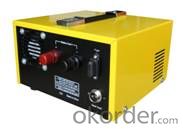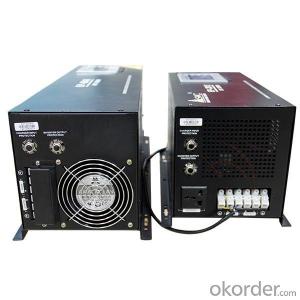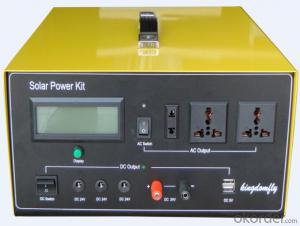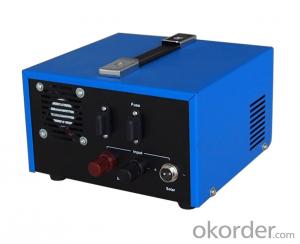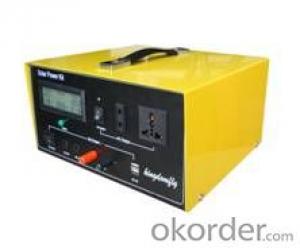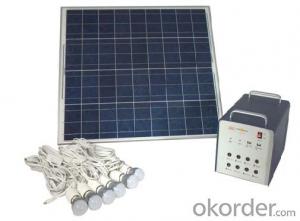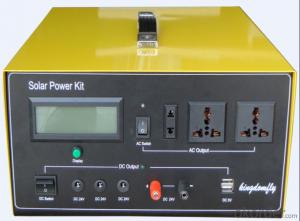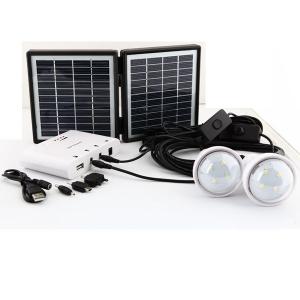Solar Energy Systems for Homes - SPK-300 LCD Solar Power System
- Loading Port:
- China main port
- Payment Terms:
- TT or LC
- Min Order Qty:
- 10 pc
- Supply Capability:
- 10000 pc/month
OKorder Service Pledge
OKorder Financial Service
You Might Also Like
A solar inverter, or PV inverter, or Solar converter, converts the variable direct current (DC) output of a photovoltaic (PV) solar panel into a utility frequency alternating current (AC) that can be fed into a commercial electrical grid or used by a local, off-grid electrical network.
It is a critical BOS–component in a photovoltaic system, allowing the use of ordinary AC-powered equipment.
Solar inverters have special functions adapted for use with photovoltaic arrays, including maximum power point tracking and anti-islanding protection.
Main Information
KDF SPK_300_LCD
This product is high performance, family used portable solar power system, which can receive energy and store it in battery outside connected to SPK by solar energy on sunny day, and supplies electric power for varies appliances such as electric fan, lighting lamps, television, portable computer etc.
It can supply power for both DC and AC electric application.
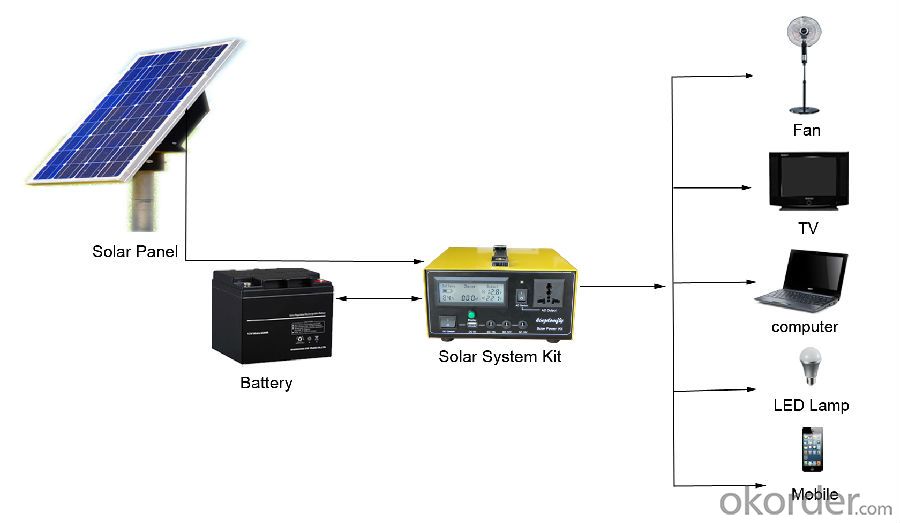
Main features:
◆ Battery puts outside connected to the SPK for user to choose battery in recommended range, and easily to exchange battery.
◆ Both DC and AC output
◆ Solar Feedback Circuit Protection
◆ Output Short-circuit Protection
◆ Solar「+」「-」anti-access protection
◆ Output「+」「-」anti-access protection
◆ Over Charged Protection
◆ Over Discharged Protection
◆ Over Load Protection
◆ Over-Temperature Protection
Technical parameters
Specification | Value/Material | |
Item No. KDF | SPK_300_LCD | |
Solar Recommended | Specification | Poly silicon |
Working Voltage/Power | 18V80W~120W | |
Battery Recommended | Rated Voltage/Capacity | 12V65AH~100AH |
Cycle Number | 80% Deep Cycle Number:500 70% Cycle Number:800 | |
Working Temperature | Short Period(one Month):-20~50℃ Long Period(Six Months):-10~45℃ | |
Charging Controller | Operating Voltage | 12V |
Input Voltage | 17.3V~21V | |
Input current | MAX:10A | |
Power Consumption | MAX: 5mA | |
Low Voltage Disconnect(LVD) | 10.8V | |
Low Voltage Reconnect(LVR) | 12.3V | |
High Voltage Discharge( HVC) | 14.6V | |
High Voltage Recharge(HVR) | 13.8V | |
Temperature Protection | 60℃ | |
DC Output | DC output & Application | USB 5V2A |
DC output & Application | DC 12V1*3A | |
AC Output | Output Wave | modified sine wave |
Input Voltage | 11V~15V | |
Output Voltage | 110V±10% | |
Output Frequency | 60Hz±2Hz/50Hz±2Hz | |
Rated Output Power | 300W | |
Maximum VA | 600VA | |
Maximum Efficiency | 88% | |
Temperature | 0-40℃ | |
Over Temperature | 60℃~70℃ | |
Low Voltage Alarm | 11V | |
Low Voltage Shut off | 10.5V | |
High Voltage Shut off | 16V | |
Package | Set size | 278*240*172mm |
Set N·W | 2.8kg | |
Set N·W | 3.6kg | |
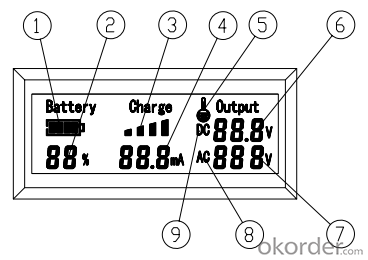
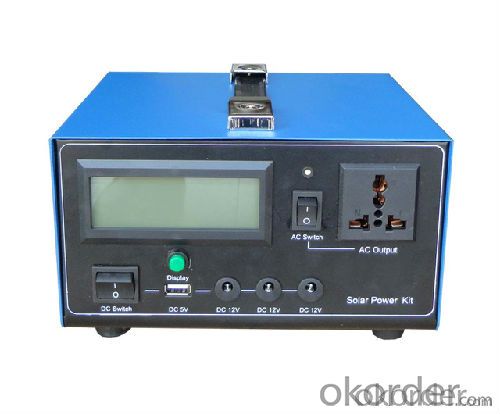
No. | Name | Function |
1 | Battery Icon | To show the Volume of the Battery |
2 | Date of % | To show the percent of the Battery |
3 | Charging Icon | To show the charging condition |
4 | Current | To show the value of charge current |
5 | Temperature Icon | Temperature Alarm |
6 | Date of Voltage | To Show the Value of DC output voltage |
7 | Date of Voltage | To Show the Value of AC output voltage |
8 | AC Icon | AC output |
9 | DC Icon | DC output |
This product can be used for any type of solar home systems. It has high conversion efficiency, reliable quality, intelligent monitoring system and best service, which will provide you with a memorable user experience and solutions.
- Q: Can solar energy systems be used for powering greenhouses?
- Indeed, greenhouses can most certainly utilize solar energy systems for power. The installation of solar panels on the greenhouse's roof or walls allows for the capture of sunlight, which is then converted into electricity. This renewable energy can subsequently be employed to power various greenhouse systems, such as lighting, cooling, heating, and ventilation. Solar energy provides several advantages for greenhouse power. Firstly, it serves as a clean and sustainable energy source, aiding in the reduction of greenhouse gas emissions and minimizing environmental impact. Secondly, solar power is both abundant and reliable, particularly in regions blessed with abundant sunlight. Consequently, greenhouses can enjoy a consistent and uninterrupted power supply, even if they are situated in remote or off-grid locations. Moreover, the integration of solar energy systems can contribute to decreased operating costs for greenhouse owners. After the initial investment in solar panels and equipment, ongoing energy expenses are significantly lower compared to traditional fossil fuel-based systems. This can result in substantial long-term savings, particularly for larger-scale commercial greenhouses. Additionally, solar energy systems can be combined with energy storage solutions like batteries to store excess energy generated during daylight hours. This stored energy can then be utilized during overcast periods or at night, ensuring an uninterrupted power supply for the greenhouse. In conclusion, solar energy systems are a viable and sustainable choice for powering greenhouses. They offer a multitude of advantages, including reduced environmental impact, a reliable energy supply, cost savings, and the ability to integrate with energy storage solutions.
- Q: Solar PV systems
- Article 1 in order to regulate the construction of distributed photovoltaic power generation project management, promote distributed photovoltaic applications, according to the "People's Republic of China renewable energy law", "People's Republic of China, People's Republic of China" power law "administrative licensing law", and the "State Council on a number of opinions" to promote the healthy development of the PV industry, these measures are formulated.
- Q: Can solar energy systems be used for heating swimming pools?
- Yes, solar energy systems can be used for heating swimming pools. Solar pool heaters use sunlight to heat the water in the pool, reducing the reliance on traditional energy sources. This is an environmentally friendly and cost-effective way to maintain a comfortable temperature in swimming pools.
- Q: Can solar energy systems be installed on recreational vehicles?
- Yes, solar energy systems can be installed on recreational vehicles.
- Q: Can solar energy systems be used in powering beauty salons or spas?
- Yes, solar energy systems can definitely be used to power beauty salons or spas. Solar energy is a renewable and sustainable source of power that can help reduce the dependence on grid electricity and minimize the carbon footprint of these establishments. By installing solar panels on the roof or other suitable areas, beauty salons and spas can generate their own electricity and reduce their energy costs in the long run. Beauty salons and spas typically require a significant amount of electricity to operate hair dryers, hair straighteners, curling irons, lighting, air conditioning, and other equipment. Solar energy systems can easily meet these power demands, especially during daylight hours when the sun is shining. Excess electricity generated during the day can be stored in batteries or fed back into the grid, ensuring a continuous supply of power at all times. Moreover, solar energy systems can help improve the sustainability and environmental performance of beauty salons and spas. By switching to solar power, these establishments can significantly reduce their carbon emissions and contribute to the fight against climate change. Additionally, using solar energy can help attract environmentally conscious customers who appreciate businesses that prioritize sustainability. In summary, solar energy systems are a viable option for powering beauty salons and spas. They can provide a reliable and sustainable source of electricity, reduce energy costs, and contribute to a greener and more environmentally friendly business operation.
- Q: What is the impact of hail on the performance of solar panels?
- Solar panels can suffer considerable damage from hail, which can vary depending on the size and velocity of the hailstones, as well as the quality and durability of the panels themselves. One immediate consequence of hail is physical harm to the surface of the solar panels. Cracks or fractures can be created by hailstones in the glass or other protective layers of the panels, compromising their ability to capture sunlight and generate electricity. These damages can also result in water infiltration, further reducing the efficiency and lifespan of the panels. Another effect of hail is the displacement or misalignment of solar cells within the panels. If hailstones strike with sufficient force, they can dislodge or shift the position of the cells, disrupting their optimal alignment and reducing the overall efficiency of the panel. This misalignment can lead to decreased energy production and a decline in performance. Furthermore, hail can damage the electrical connections and wiring within the solar panel system. Hailstones can impact the junction boxes, connectors, and cables, potentially causing them to loosen or break. This damage can result in electrical faults, reduced energy output, and even system failure if not promptly addressed. In areas prone to hailstorms, it is crucial to consider the design and installation of solar panels to reduce potential damage. Many manufacturers offer panels with tempered or reinforced glass to better withstand the impact of hailstones. Additionally, the incorporation of protective measures such as hail guards or covers can help shield the panels from direct hail damage. Regular maintenance and inspection are also essential to promptly identify and address any hail-related damages. Timely repairs or replacements of damaged panels, cells, or electrical components will help restore the performance and efficiency of the solar panel system. Overall, hail can significantly impact the performance of solar panels, potentially reducing energy production and increasing maintenance costs. However, with proper precautions, durable materials, and adequate maintenance, the potential negative impact of hail on solar panels can be minimized, ensuring the longevity and effectiveness of the solar energy system.
- Q: Can a solar energy system be installed in areas with extreme weather conditions?
- Indeed, solar energy systems have the capability of being installed in regions that experience severe weather conditions. These systems are specifically constructed to endure a broad spectrum of weather phenomena, including extreme cold, heat, wind, rain, and snow. In fact, solar panels are frequently utilized in diverse areas with intense weather conditions, such as deserts, arctic regions, and coastal zones. To guarantee the sturdiness and effectiveness of the system, solar panels are constructed using top-notch materials that possess the ability to withstand adverse weather conditions. They are designed to be resistant to impact and undergo rigorous testing to ensure they can endure hail, strong winds, and heavy snow loads. Furthermore, the frames and mounting systems employed for solar panels are engineered to provide stability and protection against extreme weather events. Even in frigid weather conditions, solar energy systems can still function efficiently, although their performance may be slightly affected by the lower temperatures. Solar panels are specifically designed to absorb sunlight, enabling them to generate electricity even under low-light circumstances. In snowy areas, solar panels are typically installed at an angle to facilitate the shedding of snow and prevent accumulation that could reduce their efficiency. In regions with scorching heat, solar energy systems can still operate effectively, albeit with a slight reduction in panel efficiency due to elevated temperatures. Nevertheless, contemporary solar panels are equipped with heat dissipation features to minimize any performance losses caused by high temperatures. In summary, solar energy systems possess remarkable adaptability and can be successfully installed in areas that experience extreme weather conditions. They are designed to withstand a wide range of weather elements, ensuring the generation of clean and renewable energy persists even in challenging environments.
- Q: Can a solar energy system be installed on a commercial parking lot?
- Installing a solar energy system on a commercial parking lot is indeed possible. In fact, these parking lots offer an excellent opportunity for solar panel installation due to their spacious and sunlit nature. Solar panels can be placed on the canopies or elevated structures of the parking lot, such as carports, which not only provide shade for parked vehicles but also generate clean and renewable energy. This has multiple benefits, including reducing the commercial establishment's carbon footprint, creating shaded parking spaces, and potentially earning revenue by selling excess energy back to the grid. Moreover, installing a solar energy system on a commercial parking lot helps to promote sustainability and environmental awareness among customers and employees, making it a mutually beneficial solution for businesses and the environment.
- Q: Are there any aesthetic considerations when installing a solar energy system?
- Yes, there are aesthetic considerations when installing a solar energy system. These include the visual impact of the system on the building or landscape, the placement and orientation of solar panels to maximize efficiency and minimize visibility, and the integration of the system with the existing architectural design.
- Q: What is the impact of hail on solar panels?
- Hail can have a detrimental impact on solar panels, as the forceful impact of hailstones can cause physical damage to the panels. This damage can result in cracks or fractures in the glass or photovoltaic cells, reducing the efficiency and effectiveness of the panels. Furthermore, hail can also impair the electrical connections within the solar panel system, leading to malfunction or complete failure. Therefore, it is important to consider protective measures, such as installing hail guards or utilizing insurance policies, to mitigate the potential damage caused by hail on solar panels.
Send your message to us
Solar Energy Systems for Homes - SPK-300 LCD Solar Power System
- Loading Port:
- China main port
- Payment Terms:
- TT or LC
- Min Order Qty:
- 10 pc
- Supply Capability:
- 10000 pc/month
OKorder Service Pledge
OKorder Financial Service
Similar products
Hot products
Hot Searches
Related keywords
